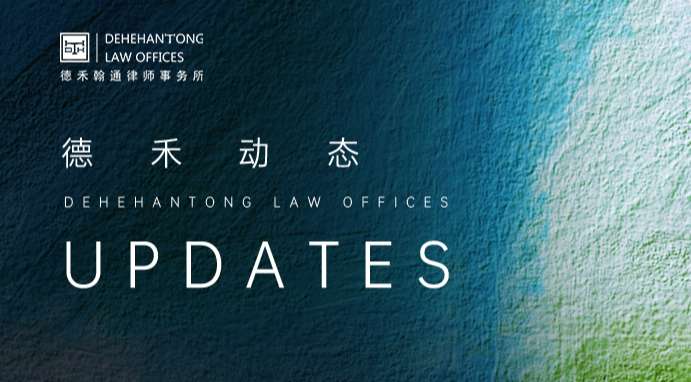New judicial interpretation on non-compete restrictions: Prohibiting Abuse, Returning to the Essence - A New judicial Approach Centered on "Trade secrets"
01 Introduction
Recently, the highly anticipated "Interpretation (II) on the Application of Law in the Trial of Labor Dispute Cases" will come into effect on September 1, 2025. We promptly sorted out the provisions concerning "non-compete restrictions" in the "Interpretation of Labor Disputes (II)" and conducted corresponding analysis and interpretation.
The provisions on "non-compete restrictions" in the "Judicial Interpretation (II) on Labor Disputes" issued by the Supreme People's Court are mainly stipulated in Articles 13, 14 and 15. The specific provisions are as follows:
Article 13: Where an employee fails to know or come into contact with the employer's trade secrets and confidential matters related to intellectual property rights, and the employee requests to confirm that the non-compete clause is not effective, the people's court shall support such request in accordance with the law.
Where the scope, geographical area, duration and other contents of the non-compete clause stipulated in the non-compete clause are inconsistent with the business secrets and confidential matters related to intellectual property rights that the employee knows or has access to, and the employee requests to confirm that the part of the non-compete clause exceeding a reasonable proportion is invalid, the people's court shall support it in accordance with the law.
Article 14: Where an employer has agreed on non-compete clauses during employment with senior management personnel, senior technical personnel and other personnel subject to confidentiality obligations, and the employee requests to confirm the non-compete clause invalid on the ground that it is not allowed to agree on non-compete clauses during employment or that economic compensation has not been paid, the people's court shall not support such request.
Article 15: Where an employee violates a valid non-compete agreement and the employer requests the employee to return the economic compensation already paid and pay a penalty as agreed, the people's court shall support such request in accordance with the law.
As we previously saw in the "Interpretation II (Draft for Comment)", under the policy background that emphasizes the free flow of production factors, "talent mobility" has become an important issue that cannot be ignored. In recent years, the phenomenon of excessive expansion and application of non-compete restrictions has become increasingly severe, and it is now time to regulate and correct them.
The new regulations on non-compete restrictions this time have two core points, which are undoubtedly two major benefits for the majority of workers.
02 Even if non-confidential personnel sign a confidentiality agreement, non-compete restrictions are still invalid
The company must provide additional evidence: whether the employee actually came into contact with the trade secrets
The root cause of the abuse of non-compete agreements: Catch-all clauses have been distorted into "Trojan horses"
Chinese law clearly defines the subjects who can sign non-compete agreements, which are limited to three types of people: senior management personnel, senior technical personnel, and other personnel with confidentiality obligations (referred to as "two senior and one confidential"). The first two types of personnel are clearly defined and have less controversy. However, the catch-all provision of "other personnel with confidentiality obligations" has gradually evolved into a "breakthrough point" for enterprises to abuse non-compete restrictions.
Many enterprises, regardless of the nature of the position or whether they have access to core information, uniformly require all employees to sign confidentiality agreements. Based on this, they claim that the employees are "persons with confidentiality obligations" and then force them to sign non-compete clauses. This "one-size-fits-all" approach seriously deviates from the legislative intent.
2. Trade Secrets: The Legitimacy Foundation of Non-compete Restrictions
Theoretically, the original intention of establishing the non-compete system is to prevent employees who hold the company's business secrets from leaving for competitors, thereby leaking or improperly using the core information of their original units. Therefore, the establishment of "two highs and one secret" is essentially a presumption mechanism - that is, it is presumed that the personnel in these positions may have access to trade secrets, and thus non-compete agreements are allowed to be signed.
In other words, the existence of trade secrets is the only legitimate basis for enterprises to restrict the freedom of job choice of workers. Without this foundation, non-compete restrictions lose their legal basis for existence.
3. Practical chaos: Non-compete agreements are deemed valid merely based on "formal confidentiality agreements"
To determine whether a worker falls under the category of "other persons with confidentiality obligations", in addition to having formally signed a confidentiality agreement, it is also necessary to conduct a substantive investigation into whether the worker has actually come into contact with trade secrets.
This excessive emphasis on formal requirements may lead to the generalized application of non-compete clauses in practice by enterprises, and to some extent, they may even become management tools, thereby affecting the normal flow of talents or possibly triggering new labor disputes.
4. There are already signs of rectifying wrongs: Insights from the cases in the database
In fact, in the case library of the People's courts, there have already been cases indicating that the review of trade secrets should be given due attention. For instance, the non-compete dispute case between Nanjing Xumu Catering Management Co., Ltd. and Liu Mouliang was included in the case database of the People's Court, which is highly representative.
In this case, the defendant was a chef responsible for mixing cucumbers. However, the company signed a non-compete agreement with him and filed a lawsuit for compensation after he moved to another catering enterprise. Obviously, it is almost impossible for a cold dish chef to have access to the core technology or business secrets of an enterprise. The so-called "obligation of confidentiality" is simply far-fetched.
The Supreme People's Court's inclusion of this case in the database is precisely to clearly convey a position: non-compete restrictions must not operate idly without the core premise of "trade secrets". The promulgation of this judicial interpretation further institutionalizes and standardizes this judicial orientation.
5. Future trend: The burden of proof for enterprises has significantly increased
In the past, when enterprises claimed that non-compete restrictions were valid, they often only needed to provide a confidentiality agreement to complete the initial evidence, and the responsibility was extremely light. However, with the implementation of the new judicial interpretation, this situation will be completely changed.
In the future, enterprises will not only have to prove that an agreement has been signed, but also must further provide evidence:
Whether the employee actually became aware of or came into contact with trade secrets during the course of performing their duties;
The specific content of the so-called "secret" and its confidentiality measures;
Whether the information has commercial value and is not known to the public.
If the above-mentioned evidence cannot be presented, the non-compete clause is very likely to be deemed invalid. This will greatly reduce the space for enterprises to abuse non-compete agreements and also bring the judgment standards back to the essence of the system.
03 Whether the new and old units constitute a competitive relationship
The judgment must be based on the substantive connection of trade secrets
Enterprises must impose an additional burden of proof: the relevance between the original job secrets and the work of new employees
If the first part addresses the issue of "whether it can be signed or not", then the second part focuses on the criteria for judging "whether there is a breach of contract".
The new judicial interpretation continues to uphold "trade secrets" as the legitimate basis for non-compete restrictions, emphasizing that only when the job responsibilities of the employee after joining the new employer are substantially related to the trade secrets they previously held can it possibly constitute a breach of contract.
Once the review standard of "substantial relevance" is introduced, it will surely profoundly affect the logic of determining "non-compete restrictions" across industries, products and positions.
Cross-industry competition will be unsustainable: specific industry fields must be clearly defined
Take a certain "Penguin Group" as an example. Its business spans multiple fields such as instant messaging, online games, film and music, and artificial intelligence. Employee Ruo was originally engaged in social platform operation at "A certain Book". After leaving the company, he joined the group to work in music copyright operation.
At this point, the "business secrets" it holds, such as the user growth strategy and community tone design of "Certain Books", have no direct connection with the distribution of music content. Therefore, listing the entire group as a prohibited area is clearly too broad and unreasonable.
In the future, if enterprises want to claim non-compete breach of contract, they must specifically explain the connection between the secrets involved by the employees and the new industry they are employed in. They can no longer infinitely expand the scope of restrictions on the grounds that "there is competition as a whole within the group".
2. The difficulty of cross-product competition increases: It is necessary to demonstrate the homogeneity of technology and the transferability of information
Even within the same industry, different product lines may target completely different technical paths, user scenarios or R&D directions, and do not constitute direct competition with each other.
For instance, an employee of A certain technology company was originally in charge of the research and development of Class A smart devices, and was proficient in specific hardware architectures and embedded system design. After leaving my job, I joined another company and was engaged in the development of B-class Internet of Things products with different functions and application scenarios. Although both belong to the field of smart hardware, their core technology stacks and product logics are significantly different. There are also different targets for the same type of symptoms.
In such circumstances, if an enterprise claims that it has breached a non-compete agreement, it is difficult to establish the claim merely on the grounds of "belonging to the same industry" or "similar product functions".
According to the orientation of the new judicial interpretation, enterprises must further provide evidence:
Whether the technical data, R&D processes or core parameters mastered in the original position have substantial overlap or reusability with the development of new products;
Whether so-called "trade secrets" can be directly or indirectly applied in new projects, thereby bringing competitive advantages.
If the substantive correlation between technologies and the transferability of information cannot be proven, merely relying on broad industry classification or superficial functional analogy will not be sufficient to determine a violation of non-compete obligations.
This will effectively curb the practice of enterprises expanding the scope of restrictions by vaguely defining "similar products", and also provide a larger space for the reasonable flow of technical personnel in specific fields.
3. Cross-position competition becomes more strict: Differences in job functions become the key defense
Even within the same company and the same product line, the information barriers between different positions can be extremely high.
For instance, an employee who was once in charge of brand public relations for video accounts on "A certain Book" has jumped ship to work as an algorithm engineer on a certain short-video platform. The former masters communication strategies and media resources, while the latter involves model training and code implementation - the information involved in the two is completely different, and there is basically no possibility of cross-use of trade secrets.
Therefore, the essential differences in job functions will become an important basis for workers to defend against non-compete breach of contract. If an enterprise wants to require its employees to fulfill the obligation of "non-compete restrictions", it must clearly demonstrate the degree of information overlap and potential risks between the two positions.
04 Conclusion: Return to the source and curb abuse
Overall, the upcoming "Judicial Interpretation on Labor Disputes (II)" marks that China is shifting from "formal compliance" to "substantive review" in the field of non-compete restrictions, and further moving towards "balancing labor rights and interests".
For workers, this means that the freedom to choose a career will be more strongly guaranteed. For enterprises, this means that they can no longer treat non-compete agreements as a "universal management tool", but must return to their original institutional intention - truly used to protect those trade secrets that are worth protecting.
It can be foreseen that in the future, when enterprises design non-compete clauses and initiate arbitration lawsuits, they will face higher compliance thresholds and heavier burden of proof. This is precisely a manifestation of safeguarding the lifeline of talent mobility while protecting innovation.
A healthy and dynamic society lies in striking a balance between safeguarding the rights and interests of enterprises and promoting the free flow of talents, rather than allowing "cucumber mixers" to be bound by non-compete restrictions as well. This is not only detrimental to personal development but may also dampen the innovative drive of the entire industry.















